Coupled Elastic–Plastic Damage Modeling of Rock Based on Irreversible Thermodynamics
Abstract
1. Introduction
2. Basic Framework of the Elastoplastic Damage Coupled Model
2.1. Thermodynamic Framework
2.2. Stress–Strain Relationship
2.3. Elastoplastic Model
2.4. Elastic Damage Model
3. Algorithm Process and Program Implementation
3.1. Elastic Prediction
3.2. Inelastic Correction
3.2.1. Damage Correction
3.2.2. Plastic Correction
3.2.3. Elastoplastic Damage Coupling Correction
3.3. Implementation of the Elastoplastic Damage Coupled Model in UMAT
4. Validation
4.1. La Biche Shale
4.1.1. Project Case
4.1.2. Parameter Selection
4.1.3. Verification Result
4.2. Eastern Yunnan–Western Chongqing Shale
4.2.1. Project Case
4.2.2. Parameter Selection
4.2.3. Verification Result
5. Model Parameter Sensitivity Analysis
6. Conclusions
- (1)
- According to irreversible thermodynamics, the damage evolution equation is defined as a function related to damage and damage-driving force. Plastic body strain increments and equivalent plastic strain increments are used to build the plastic thermodynamic potential. Additionally, the effects of confining pressure and layered structure on shale mechanical behavior are considered. Furthermore, damage, plasticity, and elastoplastic damage are coupled corrected using the regression mapping algorithm and integrated into ABAQUS 2022 through the UMAT subroutine development.
- (2)
- Simulation analysis of La Biche shale’s triaxial experiments shows that the model can reflect the characteristics of increased peak stress with confining pressure and decreased post-peak stress and simulate the volumetric expansion of shale under stress and the reduction in volumetric expansion with increased confining pressure. Further simulation analysis of the experimental data from Eastern Yunnan–Western Chongqing shale demonstrates that the constitutive model can effectively describe the increase in shale strength under high confining pressure, the macroscopic mechanical characteristics under different bedding plane angles, and the material softening behavior caused by the evolution of internal microcracks after the yield point.
- (3)
- Through parameter sensitivity analysis, it is found that the plastic hardening rate b determines the plastic hardening. The larger b is, the more evident the plastic hardening and the greater the peak strength. The damage evolution rate Bω affects the post-peak strain. The smaller Bω is, the faster the post-peak stress decreases, and the greater the strain under the same stress condition. The weighting coefficient r reflects damage behavior. The larger r is, the slower the damage grows, and the smaller the stress peak and residual strength are. The damage softening a indicates the degree of post-peak stress decrease. The larger a is, the faster the stress decreases, and the lower the peak strength and residual strength are.
Supplementary Materials
Author Contributions
Funding
Institutional Review Board Statement
Informed Consent Statement
Data Availability Statement
Conflicts of Interest
References
- Laloui, L.; Ferrari, A. Multiphysical Testing of Soils and Shales; Heidelberg Press: Berlin, Germany, 2012; Available online: https://link.springer.com/book/10.1007/978-3-642-32492-5 (accessed on 3 October 2024).
- Sie, C.Y.; Nguyen, Q.P. Field gas huff-n-puff for enhancing oil recovery in Eagle Ford shales—Effect of reservoir rock and crude properties. Fuel 2022, 328, 125127. [Google Scholar] [CrossRef]
- Xia, L.Y.; Zhao, X.Y.; Wu, Y. Status, disadvantages, and prospects of oil shale in China: An economic perspective. Energy Policy 2023, 183, 113795. [Google Scholar] [CrossRef]
- U.S. Geological Survey (USGS). World Petroleum Assessment. 1 January 2024. Available online: https://www.usgs.gov/centers/central-energy-resources-science-center/science/world-oil-and-gas-resource-assessments (accessed on 3 October 2024).
- U.S. Energy Information Administration (EIA). Technically Recoverable Shale Oil and Shale Gas Resources: An Assessment of 137 Shale Formations in 41 Countries Outside the United States. 17 May 2013. Available online: https://www.eia.gov/analysis/studies/worldshalegas/pdf/overview.pdf (accessed on 3 October 2024).
- International Energy Agency (IEA). World Energy Outlook 2023. 24 October 2023. Available online: https://www.iea.org/reports/world-energy-outlook-2023?wpappninja_v=b64a7tp1d (accessed on 3 October 2024).
- Tong, X.G.; Zhang, G.Y.; Wang, Z.M.; Wen, Z.X.; Tian, Z.J.; Wang, H.J.; Ma, F.; Wu, Y.P. Distribution and potential of global oil and gas resources. Pet. Explor. Dev. 2018, 45, 779–789. [Google Scholar] [CrossRef]
- British Petroleum (BP). bp Energy Outlook. 10 July 2024. Available online: https://www.bp.com/content/dam/bp/business-sites/en/global/corporate/pdfs/energy-economics/energy-outlook/bp-energy-outlook-2024.pdf (accessed on 3 October 2024).
- British Petroleum (BP). Statistical Review of World Energy. 8 July 2021. Available online: https://www.bp.com/content/dam/bp/business-sites/en/global/corporate/pdfs/energy-economics/statistical-review/bp-stats-review-2021-full-report.pdf (accessed on 3 October 2024).
- Economics & Technology Research Institute (ETRI). Oil and Gas Industry: 2023 Review and 2024 Outlook. 8 March 2024. Available online: https://www.cnpc.com.cn/en/nr2024/202403/66acc9d48164489392b0aa3e009f116b.shtml (accessed on 3 October 2024).
- Qi, X.Y.; Geng, D.D.; Feng, M.Y.; Xu, M.Z. Study on failure characteristics and evaluation index of aquifer shale based on energy evolution. Acta Geotech. 2024, 1, 6691–6710. [Google Scholar] [CrossRef]
- King, G.E. Hydraulic fracturing 101: What every representative, environmentalist, regulator, reporter, investor, university researcher, neighbor, and engineer should know about estimating frac risk and improving frac performance in unconventional gas and oil wells. In Proceedings of the SPE Hydraulic Fracturing Technology Conference, Woodlands, TX, USA, 6–8 February 2012. [Google Scholar] [CrossRef]
- Jin, C.R.; Cusatis, G.L. New Frontiers in Oil and Gas Exploration; International Press: New York, NY, USA, 2016; Available online: https://link.springer.com/book/10.1007/978-3-319-40124-9 (accessed on 3 October 2024).
- Li, W.P.; Zhang, D.M.; Li, M.H. Failure criteria of gas-infiltrated sandy shale based on the effective stress principle. Energies 2016, 9, 972. [Google Scholar] [CrossRef]
- Li, W.; Liu, J.S.; Zeng, J.; Leong, Y.K.; Elsworth, D.; Tian, J.W.; Li, L. A fully coupled multidomain and multiphysics model for evaluation of shale gas extraction. Fuel 2020, 278, 118214. [Google Scholar] [CrossRef]
- Heng, S.; Li, X.Z.; Liu, X.; Chen, Y. Experimental study on the mechanical properties of bedding planes in shale. J. Nat. Gas Sci. Eng. 2020, 76, 103161. [Google Scholar] [CrossRef]
- Horii, H.; Nemat-Nasser, S. Compression-induced microcrack growth in brittle solids: Axial splitting and shear failure. J. Geophys. Res. Solid Earth 1985, 90, 3105–3125. [Google Scholar] [CrossRef]
- Wong, R.C.K. Swelling and softening behaviour of La Biche shale. Can. Geotech. J. 1998, 35, 206–221. [Google Scholar] [CrossRef]
- Li, C.B.; Bažant, Z.P.; Xie, H.P.; Rahimi-Aghdam, S. Anisotropic microplane constitutive model for coupling creep and damage in layered geomaterials such as gas or oil shale. Int. J. Rock Mech. Min. Sci. 2019, 124, 104074. [Google Scholar] [CrossRef]
- Horsrud, P.; Sønstebø, E.F.; Bøe, R. Mechanical and petrophysical properties of North Sea shales. Int. J. Rock Mech. Min. Sci. 1998, 35, 1009–1020. [Google Scholar] [CrossRef]
- Wang, J.L.; Liu, M.M.; Bentley, Y.M.; Feng, L.Y.; Zhang, C.H. Water use for shale gas extraction in the Sichuan Basin, China. J. Environ. Manag. 2018, 226, 13–21. [Google Scholar] [CrossRef] [PubMed]
- Fan, Z.D.; Xie, H.P.; Sun, X.; Zhang, R.; Li, C.B.; Zhang, Z.T.; Xie, J.; Wang, J.; Ren, L. Crack deflection in shale-like layered rocks under three-point bend loading. Eng. Fract. Mech. 2023, 289, 109464. [Google Scholar] [CrossRef]
- Niandou, H.; Shao, J.F.; Henry, J.P.; Fourmaintraux, D. Laboratory investigation of the mechanical behaviour of Tournemire shale. Int. J. Rock Mech. Min. Sci. 1997, 34, 3–16. [Google Scholar] [CrossRef]
- Jaeger, J.C.; Cook, N.G.W.; Zimmerman, R.W. Fundamentals of Rock Mechanics; Blackwell Press: London, UK, 2007; Available online: https://www.researchgate.net/publication/220010592 (accessed on 3 October 2024).
- Mou, P.W.; Pan, J.N.; Wang, K.; Wei, J.; Yang, Y.H.; Wang, X.L. Influences of hydraulic fracturing on microfractures of high-rank coal under different in-situ stress conditions. Fuel 2021, 287, 119566. [Google Scholar] [CrossRef]
- Zhou, H.; Zhang, K.; Feng, X. A Coupled Elasto-Plastic-Damage Mechanical Model for Marble. Sci. China Technol. Sci. 2011, 54, 228–234. [Google Scholar] [CrossRef]
- Liu, W.B.; Zhang, S.G. An improved unsteady creep model based on the time dependent mechanical parameters. Mech. Adv. Mater. Struct. 2021, 28, 1838–1848. [Google Scholar] [CrossRef]
- Qiu, S.L.; Feng, X.T.; Xiao, J.Q.; Zhang, C.Q. An experimental study on the pre-peak unloading damage evolution of marble. Rock Mech. Rock Eng. 2014, 47, 401–419. [Google Scholar] [CrossRef]
- Cerfontaine, B.; Charlier, R.; Collin, F.; Taiebat, M. Validation of a new elastoplastic constitutive model dedicated to the cyclic behaviour of brittle rock materials. Rock Mech. Rock Eng. 2017, 50, 2677–2694. [Google Scholar] [CrossRef]
- Meng, X.J.; Geng, D.; Liu, S.K. The modified Mohr-Coulomb model considering softening effect and intermediate principal stress. Mech. Adv. Mater. Struct. 2024, 1–15. [Google Scholar] [CrossRef]
- Li, Q.; Franci, A.; Li, H.; Li, P.; Li, T.L.; Shang, C.S. Modified discontinuous deformation analysis with mixed bilinear failure model for investigating quasi-brittle failure in geo-materials. Comput. Geotech. 2024, 173, 106536. [Google Scholar] [CrossRef]
- Shao, J.F.; Zhu, Q.Z.; Su, K. Modeling of creep in rock materials in terms of material degradation. Comput. Geotech. 2003, 30, 549–555. [Google Scholar] [CrossRef]
- He, J.L.; Niu, F.J.; Su, W.J.; Jiang, H.Q. Nonlinear unified strength criterion for frozen soil based on homogenization theory. Mech. Adv. Mater. Struct. 2023, 30, 4002–4015. [Google Scholar] [CrossRef]
- Zhu, Q.Z.; Kondo, D.; Shao, J.F. Micromechanical analysis of coupling between anisotropic damage and friction in quasi-brittle materials: Role of the homogenization scheme. Int. J. Solids Struct. 2008, 45, 1385–1405. [Google Scholar] [CrossRef]
- Zhu, Q.Z.; Zhou, C.B.; Shao, J.F.; Kondo, D. A discrete thermodynamic approach for anisotropic plastic-damage modeling of cohesive-frictional geomaterials. Int. J. Numer. Anal. Methods Geomech. 2010, 34, 1250–1270. [Google Scholar] [CrossRef]
- Unteregger, D.; Fuchs, B.; Hofstetter, G. A damage plasticity model for different types of intact rock. Int. J. Rock Mech. Min. Sci. 2015, 80, 402–411. [Google Scholar] [CrossRef]
- Wang, H.Y.; Zhang, Q.; Wu, P.N.; Li, Y.J.; Han, L.J.; Han, G.L. Elastoplastic solution of a circular tunnel in surrounding rock with any nonlinear yield criteria and plastic flow envelopes. Comput. Geotech. 2024, 166, 105954. [Google Scholar] [CrossRef]
- Kamdem, T.C.; Richard, K.G.; Béda, T. Modeling the mechanical behavior of rock during plastic flow using fractional calculus theory. Appl. Math. Model. 2024, 130, 790–805. [Google Scholar] [CrossRef]
- Sarout, J.; Molez, L.; Guéguen, Y.; Hoteit, N. Shale dynamic properties and anisotropy under triaxial loading: Experimental and theoretical investigations. Phys. Chem. Earth 2007, 32, 896–906. [Google Scholar] [CrossRef]
- Zhu, Q.Z.; Shao, J.F.; Mainguy, M. A micromechanics-based elastoplastic damage model for granular materials at low confining pressure. Int. J. Plast. 2010, 26, 586–602. [Google Scholar] [CrossRef]
- Li, Y.K.; Du, B.; Shen, M.X. A nonlinear creep model for transversely isotropic rock based on fractional calculus theory. Mech. Adv. Mater. Struct. 2023, 1–11. [Google Scholar] [CrossRef]
- Sone, H.; Zoback, M.D. Mechanical properties of shale-gas reservoir rocks—Part 1: Static and dynamic elastic properties and anisotropy. Geophysics 2013, 78, 381–392. [Google Scholar] [CrossRef]
- Sone, H.; Zoback, M.D. Time-dependent deformation of shale gas reservoir rocks and its long-term effect on the in situ state of stress. Int. J. Rock Mech. Min. Sci. 2014, 69, 120–132. [Google Scholar] [CrossRef]
- Mousavi Nezhad, M.; Fisher, Q.J.; Gironacci, E.; Rezania, M. Experimental study and numerical modeling of fracture propagation in shale rocks during Brazilian disk test. Rock Mech. Rock Eng. 2018, 51, 1755–1775. [Google Scholar] [CrossRef]
- Ip, S.C.; Choo, J.; Borja, R.I. Impacts of saturation-dependent anisotropy on the shrinkage behavior of clay rocks. Acta Geotech. 2021, 16, 3381–3400. [Google Scholar] [CrossRef]
- Ip, S.C.; Borja, R.I. Multiscale interactions of elastic anisotropy in unsaturated clayey rocks using a homogenization model. Acta Geotech. 2023, 18, 2289–2307. [Google Scholar] [CrossRef]
- Ip, S.C.; Borja, R.I. Evolution of anisotropy with saturation and its implications for the elastoplastic responses of clay rocks. Int. J. Numer. Anal. Methods Geomech. 2022, 46, 23–46. [Google Scholar] [CrossRef]
- Cao, Y.J.; Wang, W.; Shen, W.Q.; Cui, X.Y.; Shao, J.F. A new hybrid phase-field model for modeling mixed-mode cracking process in anisotropic plastic rock-like materials. Int. J. Plast. 2022, 157, 103395. [Google Scholar] [CrossRef]
- Dragon, A.; Mroz, Z. A continuum model for plastic-brittle behaviour of rock and concrete. Internat. J. Engrg. Sci. 1979, 17, 121–137. [Google Scholar] [CrossRef]
- Frantziskonis, G.; Desai, C. Elastoplastic model with damage for strain softening geomaterials. Acta Mech. 1987, 68, 151–170. [Google Scholar] [CrossRef]
- Rouabhi, A.; Tijani, M.; Rejeb, A. Triaxial behaviour of transversely isotropic materials: Application to sedimentary rocks. Int. J. Numer. Anal. Methods Geomech. 2007, 31, 1517–1535. [Google Scholar] [CrossRef]
- Chen, L.; Wang, C.P.; Liu, J.F.; Liu, J.; Wang, J.; Jia, Y.; Shao, J.F. Damage and plastic deformation modeling of Beishan granite under compressive stress conditions. Rock Mech. Rock Eng. 2015, 48, 1623–1633. [Google Scholar] [CrossRef]
- Zhang, J.C.; Xu, W.Y.; Wang, H.L.; Wang, R.B.; Meng, Q.X. Testing and modeling of the mechanical behavior of dolomite in the Wudongde hydropower plant. Geomech. Geoeng. 2016, 11, 270–280. [Google Scholar] [CrossRef]
- Zhao, Y.; Semnani, S.J.; Yin, Q.; Borja, R.I. On the strength of transversely isotropic rocks. Int. J. Numer. Anal. Methods Geomech. 2018, 42, 1917–1934. [Google Scholar] [CrossRef]
- Kraipru, K.; Fuenkajorn, K.; Thongprapha, T. The effect of transverse isotropy on the creep behavior of bedded salt under confining pressures. Mech. Time-Depend. Mater. 2024, 28, 2879–2897. [Google Scholar] [CrossRef]
- Duan, S.Q.; Liu, S.H.; Xiong, J.C.; Xu, D.P.; Xu, L.B.; Jiang, X.Q.; Zhang, M.H.; Liu, G.F. Investigation on uncoordinated deformation and failure mechanism and damage modeling of rock mass with weak interlayer zone. Eng. Fail. Anal. 2024, 163, 108563. [Google Scholar] [CrossRef]
- Cauvin, A.; Testa, R.B. Damage mechanics: Basic variables in continuum theories. Int. J. Solids Struct. 1999, 36, 747–761. [Google Scholar] [CrossRef]
- Challamel, N.; Lanos, C.; Casandjian, C. Strain-based anisotropic damage modelling and unilateral effects. Int. J. Mech. Sci. 2005, 47, 459–473. [Google Scholar] [CrossRef]
- Liu, S.J.; Wang, Z.Q.; Kou, M.M.; Zhang, Y.J.; Wang, Y.L. Phase-field simulations of unloading failure behaviors in rock and rock-like materials. Theor. Appl. Fract. Mech. 2023, 126, 103936. [Google Scholar] [CrossRef]
- Lu, J.F.; Yin, T.B.; Guo, W.X.; Men, J.Q.; Ma, J.X.; Yang, Z.; Chen, D.C. Dynamic response and constitutive model of damaged sandstone after triaxial impact. Eng. Fail. Anal. 2024, 163, 108450. [Google Scholar] [CrossRef]
- Zhang, J.C. Experimental and modelling investigations of the coupled elastoplastic damage of a quasi-brittle rock. Rock Mech. Rock Eng. 2018, 51, 465–478. [Google Scholar] [CrossRef]
- Li, Y.Q.; Huang, D.; Song, Y. Energy evolution and damage model of sandstone under seepage-creep-disturbance loading. Mech. Adv. Mater. Struct. 2024, 1–21. [Google Scholar] [CrossRef]
- Pensée, V.; Kondo, D.; Dormieux, L. Micromechanical analysis of anisotropic damage in brittle materials. J. Eng. Mech. 2002, 128, 889–897. [Google Scholar] [CrossRef]
- Hu, D.W.; Zhu, Q.Z.; Zhou, H.; Shao, J.F. A discrete approach for anisotropic plasticity and damage in semi-brittle rocks. Comput. Geotech. 2010, 37, 658–666. [Google Scholar] [CrossRef]
- Xie, N.; Zhu, Q.Z.; Xu, L.H.; Shao, J.F. A micromechanics-based elastoplastic damage model for quasi-brittle rocks. Comput. Geotech. 2011, 38, 970–977. [Google Scholar] [CrossRef]
- Zhu, Q.Z.; Shao, J.F. A refined micromechanical damage-friction model with strength prediction for rock-like materials under compression. Int. J. Solids Struct. 2015, 60–61, 75–83. [Google Scholar] [CrossRef]
- Shao, J.F.; Jia, Y.; Kondo, D.; Chiarelli, A. A coupled elastoplastic damage model for semi-brittle materials and extension to unsaturated conditions. Mech. Mater. 2006, 38, 218–232. [Google Scholar] [CrossRef]
- Parisio, F.; Samat, S.; Laloui, L. Constitutive analysis of shale: A coupled damage plasticity approach. Int. J. Solids Struct. 2015, 75–76, 88–98. [Google Scholar] [CrossRef]
- Zhang, J.C.; Xu, W.Y.; Wang, H.L.; Wang, R.B.; Meng, Q.X.; Du, S.W. A coupled elastoplastic damage model for brittle rocks and its application in modelling underground excavation. Int. J. Rock Mech. Min. Sci. 2016, 84, 130–141. [Google Scholar] [CrossRef]
- Ma, S.Q.; Gutierrez, M.; Hou, Z.K. Coupled plasticity and damage constitutive model considering residual shear strength for shales. Int. J. Geomech. 2020, 20, 04020109. [Google Scholar] [CrossRef]
- Chen, H.G.; Zhao, C.; Zhang, R.; Xing, J.Q.; Huang, L.; Qian, Y. Macro-micro damage model of the effect of freeze-thaw on jointed rocks considering compaction deformation. Eng. Fail. Anal. 2023, 151, 107407. [Google Scholar] [CrossRef]
- Shao, J.F.; Chau, K.T.; Feng, X.T. Modeling of anisotropic damage and creep deformation in brittle rocks. Int. J. Rock Mech. Min. Sci. 2006, 43, 582–592. [Google Scholar] [CrossRef]
- Leoni, M.; Karstunen, M.; Vermeer, P. Anisotropic creep model for soft soils. Geotechnique 2008, 58, 215–226. [Google Scholar] [CrossRef]
- Liu, X.S.; Ning, J.G.; Tan, Y.L.; Gu, Q.H. Damage constitutive model based on energy dissipation for intact rock subjected to cyclic loading. Int. J. Rock Mech. Min. Sci. 2016, 85, 27–32. [Google Scholar] [CrossRef]
- Song, Z.Y.; Konietzky, H.; Frühwirt, T. Hysteresis energy-based failure indicators for concrete and brittle rocks under the condition of fatigue loading. Int. J. Fatigue 2018, 114, 298–310. [Google Scholar] [CrossRef]
- Wang, X.L.; Zhao, Y.X.; Gao, Y.R.; Sun, Z.; Liu, B.; Jiang, Y.D. Energy evolution of anthracite considering anisotropy under high confining pressure: An experimental investigation. J. Rock Mech. Rock Eng. 2023, 56, 6735–6759. [Google Scholar] [CrossRef]
- Rummel, F.; Fairhurst, C. Determination of the post-failure behavior of brittle rock using a servo-controlled testing machine. Rock Mech. 1970, 2, 189–204. [Google Scholar] [CrossRef]
- Murakami, S.; Kamiya, K. Constitutive and damage evolution equations of elastic-brittle materials based on irreversible thermodynamics. Int. J. Mech. Sci. 1997, 39, 473–486. [Google Scholar] [CrossRef]
- Peng, Y.Y.; Zhou, C.; Fu, C.F.; Zhong, Z.; Wang, J.J. Study on energy damage evolution of multi-flaw sandstone with different flaw lengths. Theor. Appl. Fract. Mech. 2024, 132, 104469. [Google Scholar] [CrossRef]
- Zhai, Y.; Meng, F.D.; Li, Y.B.; Li, Y.; Zhao, R.F.; Zhang, Y.S. Research on dynamic compression failure characteristics and damage constitutive model of sandstone after freeze-thaw cycles. Eng. Fail. Anal. 2022, 140, 106577. [Google Scholar] [CrossRef]
- Lemaitre, J. Evaluation of dissipation and damage in metals submitted to dynamic loading. Int. Conf. Mech. Behav. Mater. 1971, 5, 329–345. [Google Scholar] [CrossRef]
- Salari, M.R.; Saeb, S.A.; Willam, K.J.; Patchet, S.J.; Carrasco, R.C. A coupled elastoplastic damage model for geomaterials. Comput. Methods Appl. Mech. Eng. 2004, 193, 2625–2643. [Google Scholar] [CrossRef]
- Yang, S.Q.; Jing, H.W.; Wang, S.Y. Experimental investigation on the strength, deformability, failure behavior and acoustic emission locations of red sandstone under triaxial compression. Rock Mech. Rock Eng. 2012, 45, 583–606. [Google Scholar] [CrossRef]
- Zhao, X.G.; Cai, M.; Wang, J.; Ma, L.K. Damage stress and acoustic emission characteristics of the Beishan granite. Int. J. Rock Mech. Min. Sci. 2013, 64, 258–269. [Google Scholar] [CrossRef]
- Lubarda, V. On thermodynamic potentials in linear thermoelasticity. Int. J. Solids Struct. 2004, 41, 7377–7398. [Google Scholar] [CrossRef]
- Kolomiets, V.I.; Bekker, A.T. Level of allowable stresses under cyclic variable-polarity thermal fields impact to concretes. In Proceedings of the ISOPE Pacific/Asia Offshore Mechanics Symposium, Vladivostok, Russia, 12–16 September 2004; Available online: https://onepetro.org/ISOPEPACOMS/proceedings-abstract/PACOMS04/All-PACOMS04/25687 (accessed on 3 October 2024).
- Drucker, D.C.; Prager, W. Soil mechanics and plastic analysis or limit design. Q. Appl. Math. 1952, 10, 157–165. [Google Scholar] [CrossRef]
- Ding, X.; Chen, N.; Zhang, F.; Zhang, G.Q. Evolution of strength parameters for sandstone specimens during triaxial compression tests. Adv. Civ. Eng. 2021, 2021, 8856743. [Google Scholar] [CrossRef]
- Bennett, K.C.; Regueiro, R.A.; Luscher, D.J. Anisotropic finite hyper-elastoplasticity of geomaterials with Drucker-Prager/cap type constitutive model formulation. Int. J. Plast. 2019, 123, 224–250. [Google Scholar] [CrossRef]
- Chen, P.J.; Dai, X.W.; Baldino, S.; Huang, T.; Deng, X.; Tan, Z.H.; Yan, S. A continuous surface cap model and computational framework for shale under high confining pressure. Geoenergy Sci. Eng. 2023, 230, 212186. [Google Scholar] [CrossRef]
- Zhang, S.K.; Liao, S.Z.; Li, S.M.; Hu, J.H. Influence of engineering parameters on fracture vertical propagation in deep shale reservoir: A numerical study based on FEM. ACS Omega 2024, 9, 4635–4646. [Google Scholar] [CrossRef]
- Saroglou, H.; Tsiambaos, G. A modified Hoek-Brown failure criterion for anisotropic intact rock. Int. J. Rock Mech. Min. Sci. 2008, 45, 223–234. [Google Scholar] [CrossRef]
- Ismael, M.A.; Imam, H.F.; El-Shayeb, Y. A simplified approach to directly consider intact rock anisotropy in Hoek-Brown failure criterion. J. Rock Mech. Geotech. Eng. 2014, 6, 486–492. [Google Scholar] [CrossRef]
- Zheng, Y.N.; Jia, C.J.; Zhang, S.; Shi, C. Experimental and constitutive modeling of the anisotropic mechanical properties of shale subjected to thermal treatment. Geomech. Energy Environ. 2023, 35, 100485. [Google Scholar] [CrossRef]
- Winhausen, L.; Khaledi, K.; Jalali, M.; Bretthauer, M.; Amann, F. The anisotropic behavior of a clay shale: Strength, hydro-mechanical couplings, and failure processes. J. Geophys. Res. Solid Earth 2023, 128, e2023JB027382. [Google Scholar] [CrossRef]
- Jia, C.J.; Zhang, S.; Xu, W.Y. Experimental investigation and numerical modeling of coupled elastoplastic damage and permeability of saturated hard rock. Rock Mech. Rock Eng. 2021, 54, 1151–1169. [Google Scholar] [CrossRef]
- Krajcinovic, D.; Silva, M.A.G. Statistical aspects of the continuous damage theory. Int. J. Solids Struct. 1982, 18, 551–562. [Google Scholar] [CrossRef]
- Cao, W.G.; Zhao, H.; Li, X.; Zhang, Y.J. Statistical damage model with strain softening and hardening for rocks under the influence of voids and volume changes. Can. Geotech. J. 2010, 47, 857–871. [Google Scholar] [CrossRef]
- Zhao, H.; Shi, C.J.; Zhao, M.H.; Li, X.B. Statistical damage constitutive model for rocks considering residual strength. Int. J. Geomech. 2017, 17, 04016033. [Google Scholar] [CrossRef]
- Clausen, J.; Damkilde, L.; Andersen, L. An efficient return algorithm for non-associated plasticity with linear yield criteria in principal stress space. Comput. Struct. 2007, 85, 1795–1807. [Google Scholar] [CrossRef]
- Huang, J.; Griffiths, D.V. Observations on return mapping algorithms for piecewise linear yield criteria. Int. J. Geomech. 2008, 8, 253–265. [Google Scholar] [CrossRef]
- Rahman, A.; Shahriar, M.S.; Timms, G.; Lindley, C.; Davie, A.B.; Biggins, D.; Hellicar, A.; Sennersten, C.; Smith, G.; Coombe, M. A machine learning approach to find association between imaging features and XRF signatures of rocks in underground mines. In Proceedings of the 2015 IEEE Sensors, Busan, Republic of Korea, 1–4 November 2015. [Google Scholar] [CrossRef]
- Zhang, T.; Xu, W.Y.; Wang, H.L.; Wang, R.B.; Xu, J.R.; Hu, M.T. Experimental investigation on hydromechanical behavior of basalt and numerical modeling by return mapping algorithms. Bull. Eng. Geol. Environ. 2023, 82, 132. [Google Scholar] [CrossRef]
- McCrossan, R.G.; Glaister, R.P.; Austin, G.H.; Nelson, S.J. Upper Cretaceous. In Geological History of Western Canada. Alta. Soc. Petr. Geol. 1970, 12, 169–188. [Google Scholar] [CrossRef]
- Hein, F.J.; Cotterill, D.K. The Athabasca oil sands—A regional geological perspective, Fort McMurray area, Alberta, Canada. Nat. Resour. Res. 2006, 15, 85–102. [Google Scholar] [CrossRef]
- Pinyol, N.; Vaunat, J.; Alonso, E.E. A constitutive model for soft clayey rocks that includes weathering effects. In Stiff Sedimentary Clays: Genesis and Engineering Behaviour: Géotechnique Symposium in Print 2007; ICE Publishing: London, UK, 2007; pp. 193–207. [Google Scholar] [CrossRef]
- Huo, L.; Yang, C.H.; Mao, H.J.; Liu, J.X.; Yuan, Y.S. Experimental research on mechanical properties of western Hubei-Eastern Chongqing carbonaceous shale cap rock under unloading stress path. Chin. J. Rock Mech. Eng. 2016, 35 (Suppl. S1), 2898–2906. [Google Scholar] [CrossRef]
- Yuan, Y.S.; Lin, J.H.; Cheng, X.Y.; Li, S.J. Yanshan—Himalayan denudation in Western Hubei—Eastern Chongqing. Chin. J. Geophys. 2014, 57, 2878–2884. [Google Scholar] [CrossRef]
- Guo, Z.F.; Chen, M.K.; Fu, Y.X.; Chen, X.H. Natural gas reservoiring conditions of Sinian and Cambrian from western Hubei to eastern Chongqing areas. J. Southwest Pet. Univ. Sci. Technol. 2008, 30, 3–5. [Google Scholar] [CrossRef]
- Zhang, Y.Z. Study on anisotropy of mechanical properties of the shale in West Hubei and East Chongqing. Master’s Thesis, Southwest University of Science and Technology, Mianyang City, China, 1 July 2016. Available online: https://cdmd.cnki.com.cn/Article/CDMD-10619-1016118914.htm (accessed on 3 October 2024).
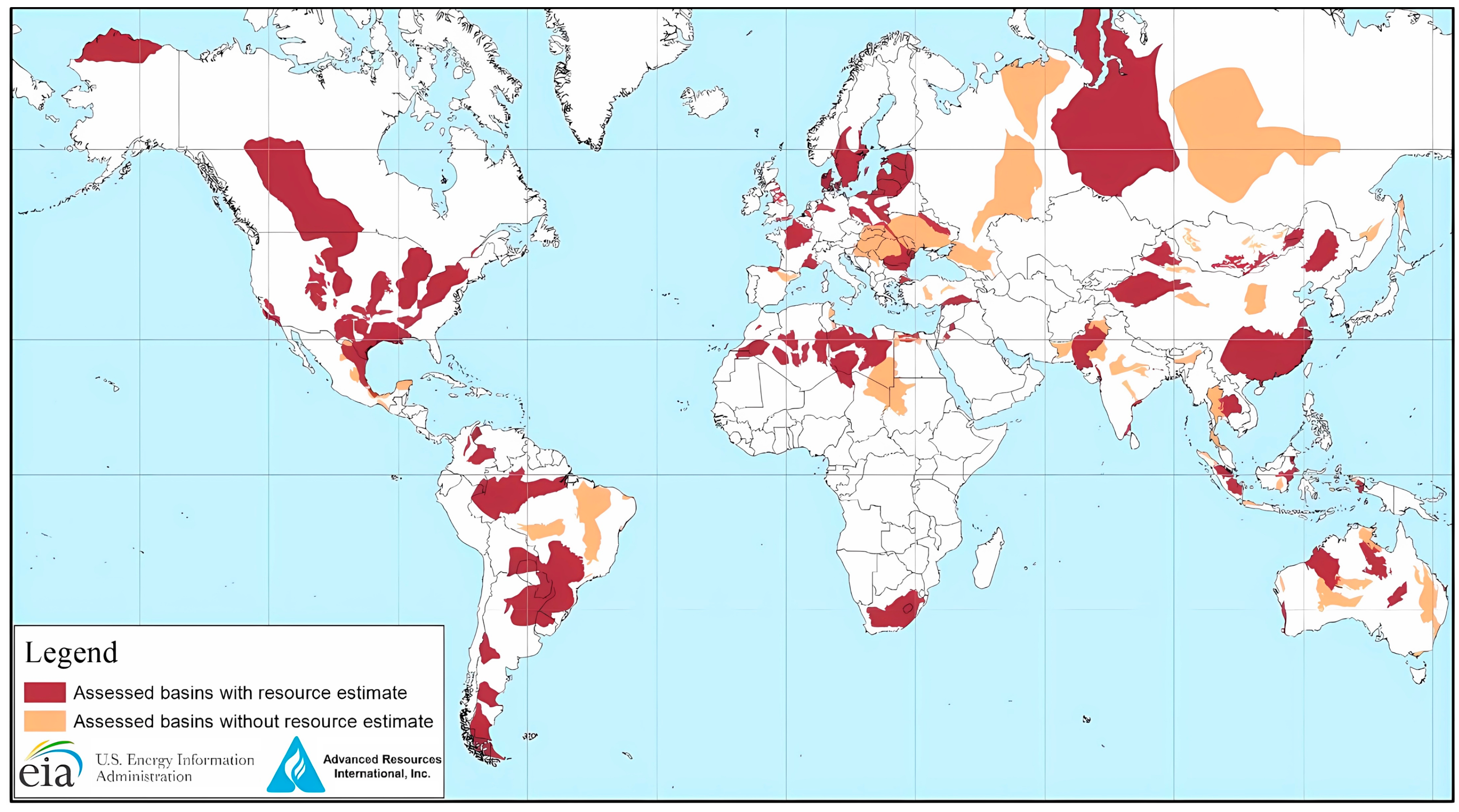
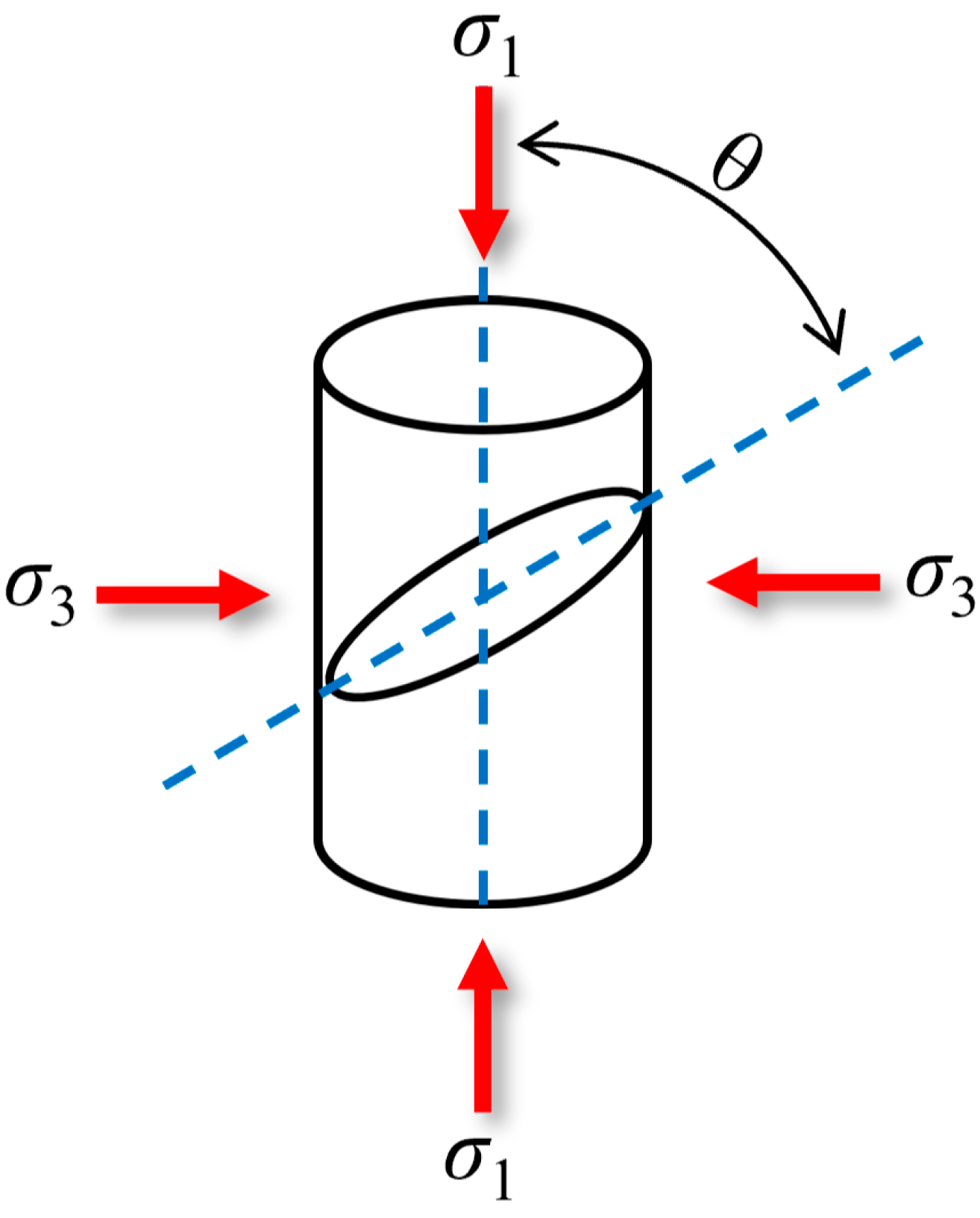
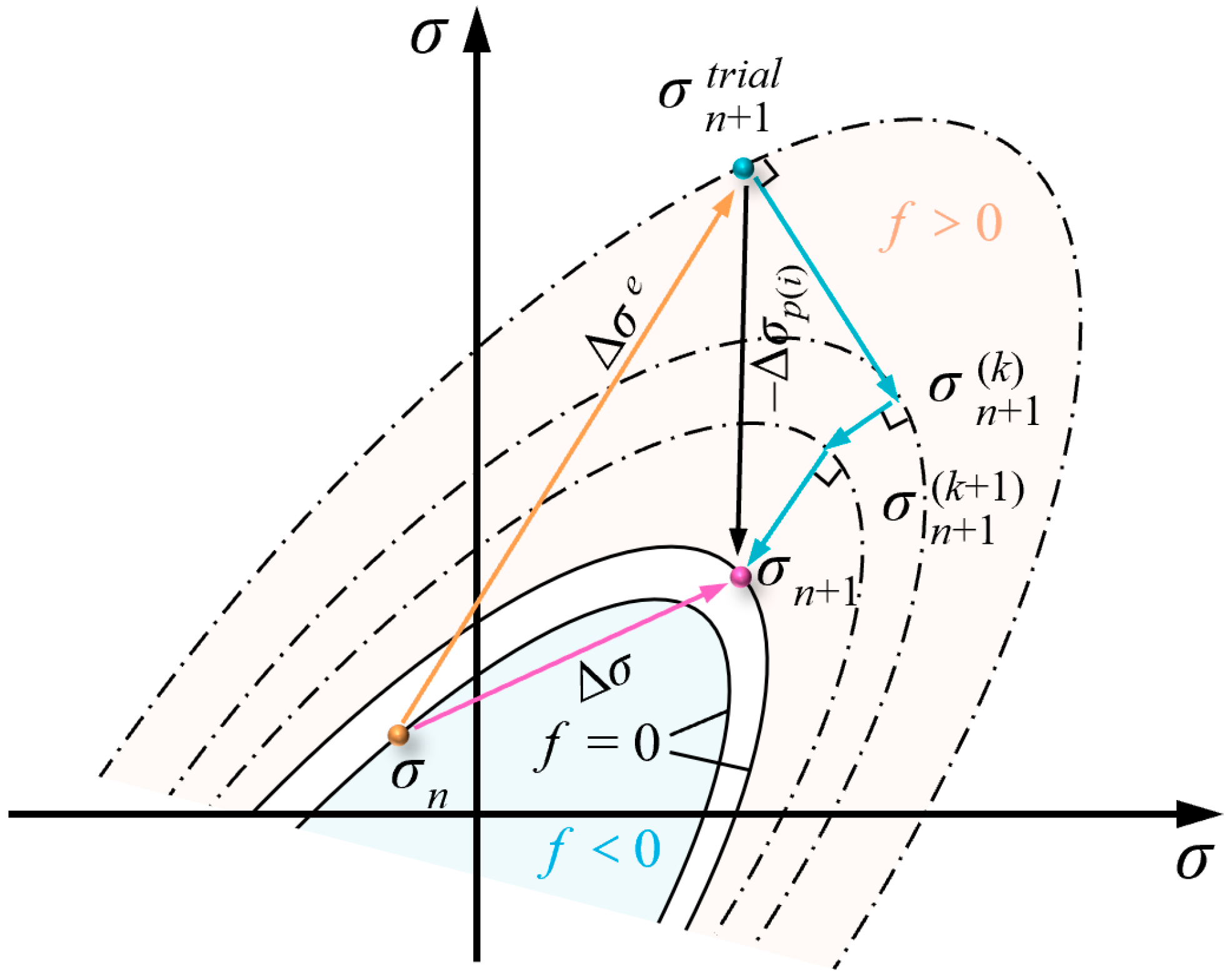
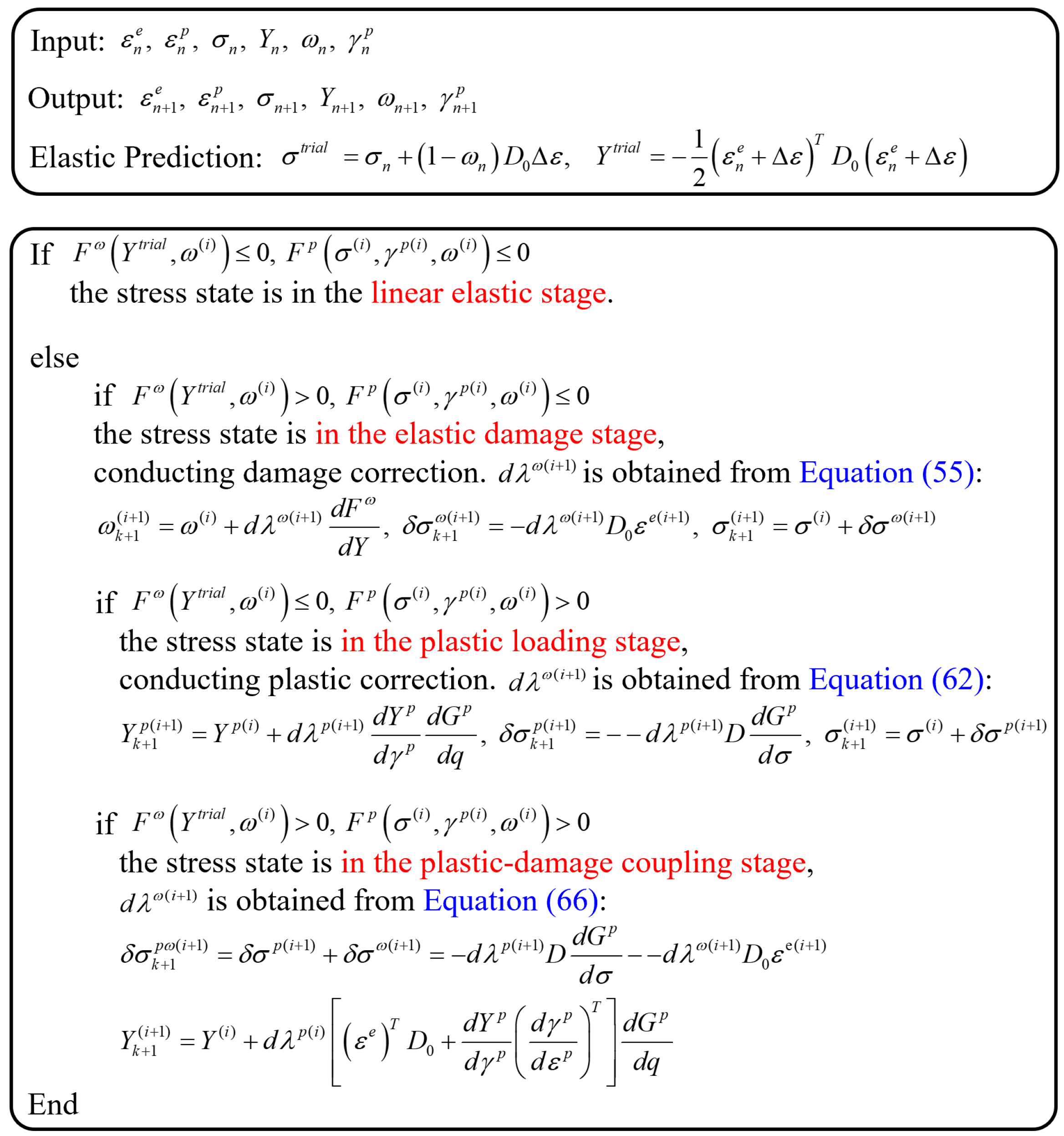
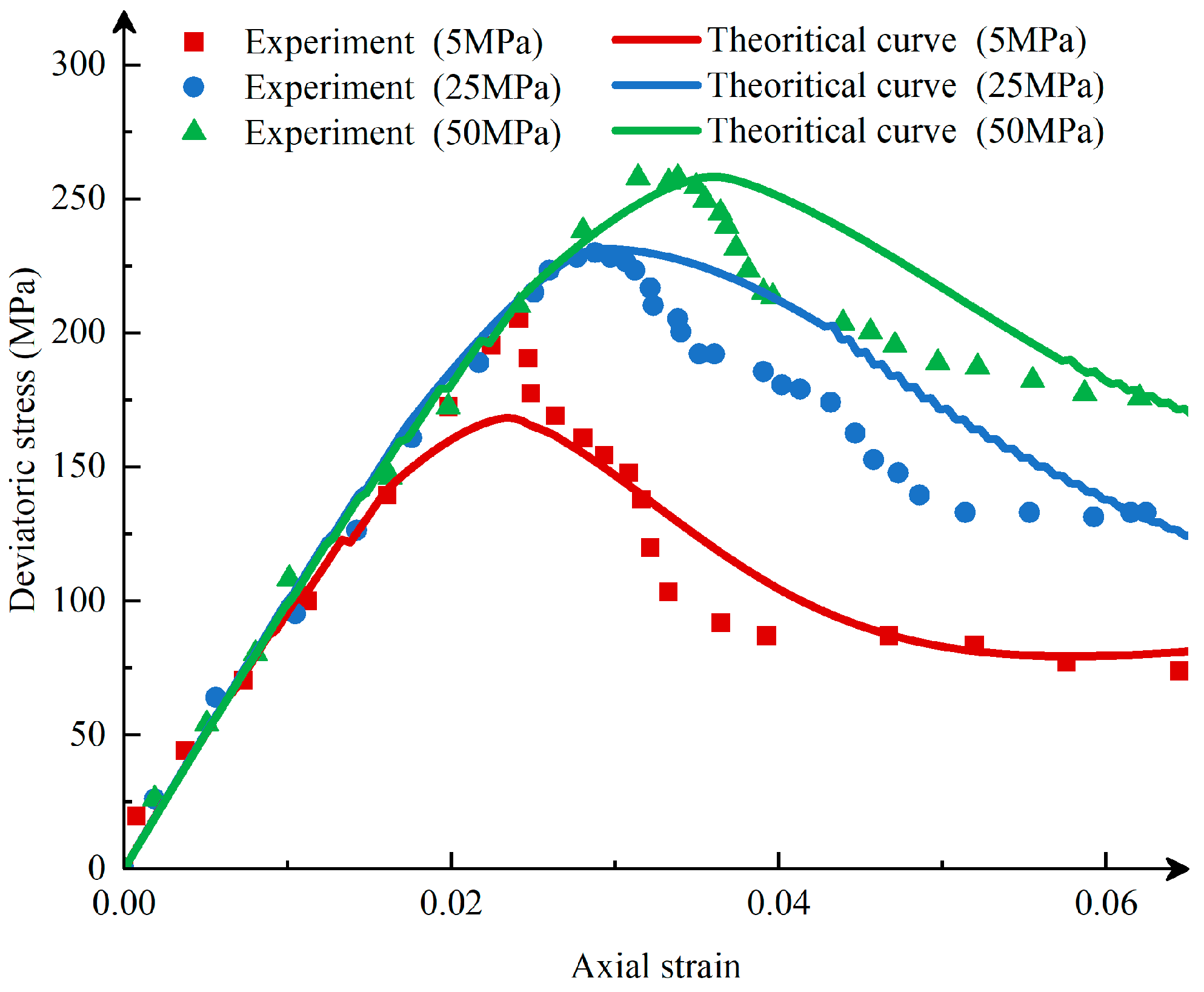
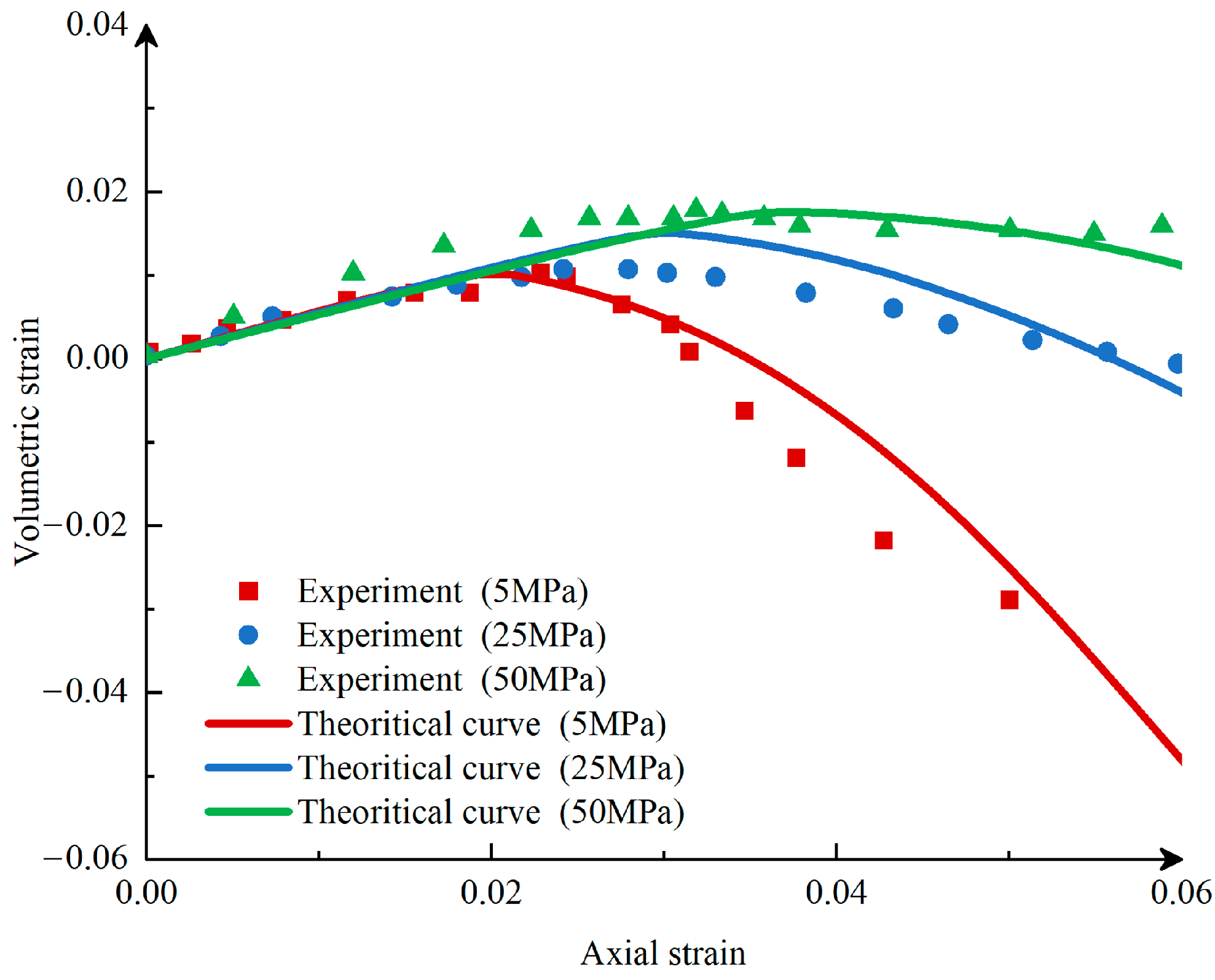
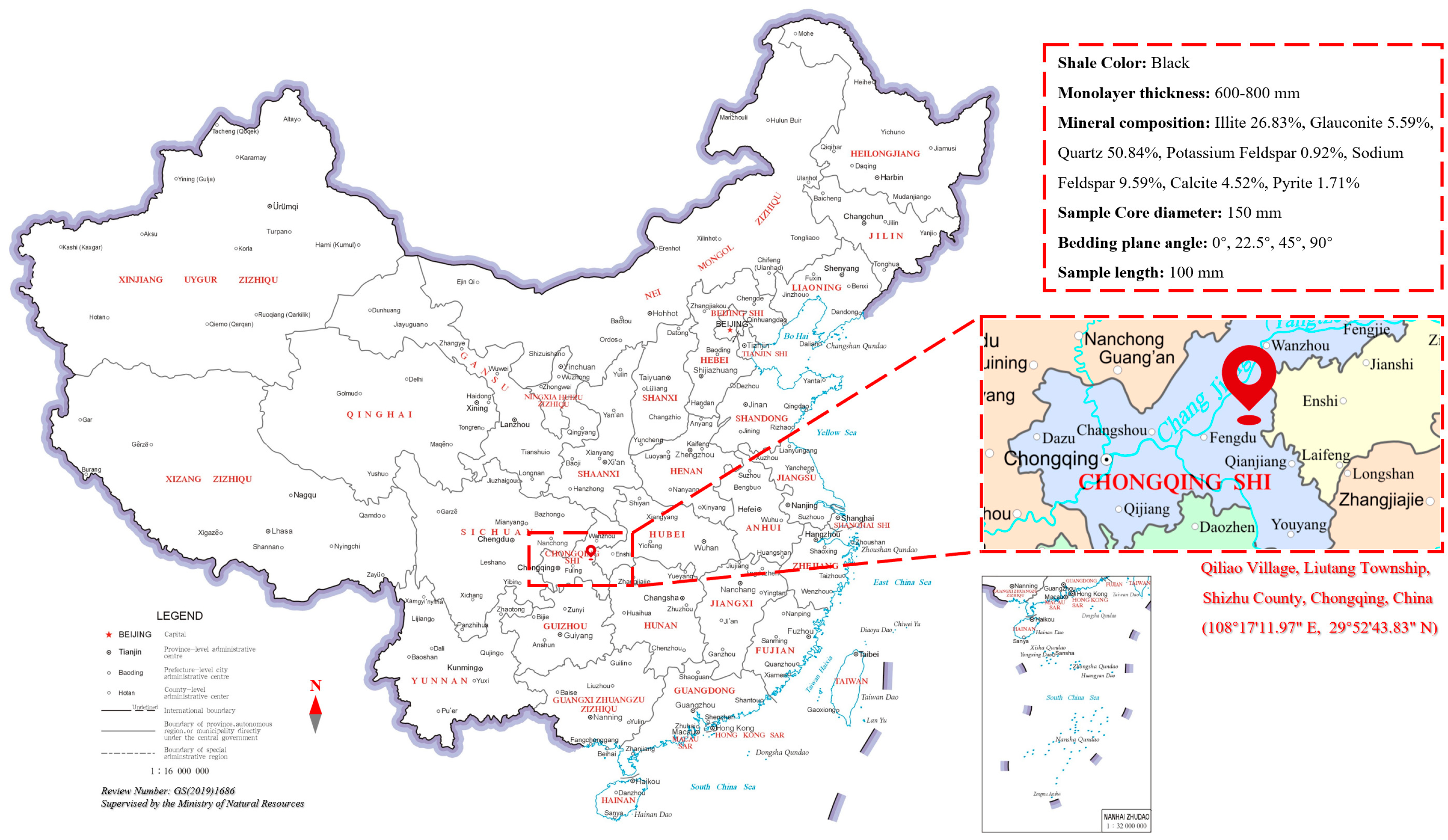
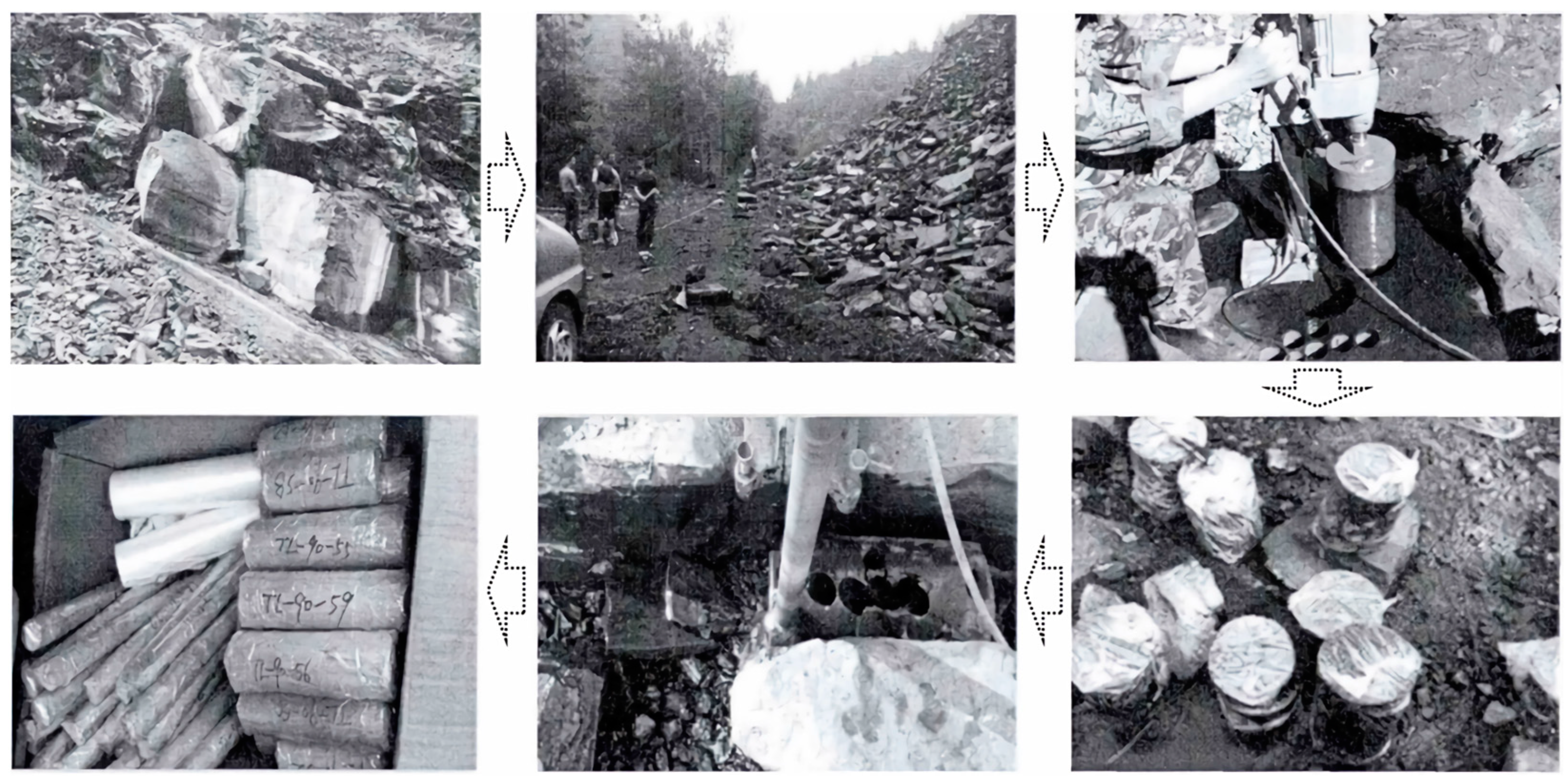
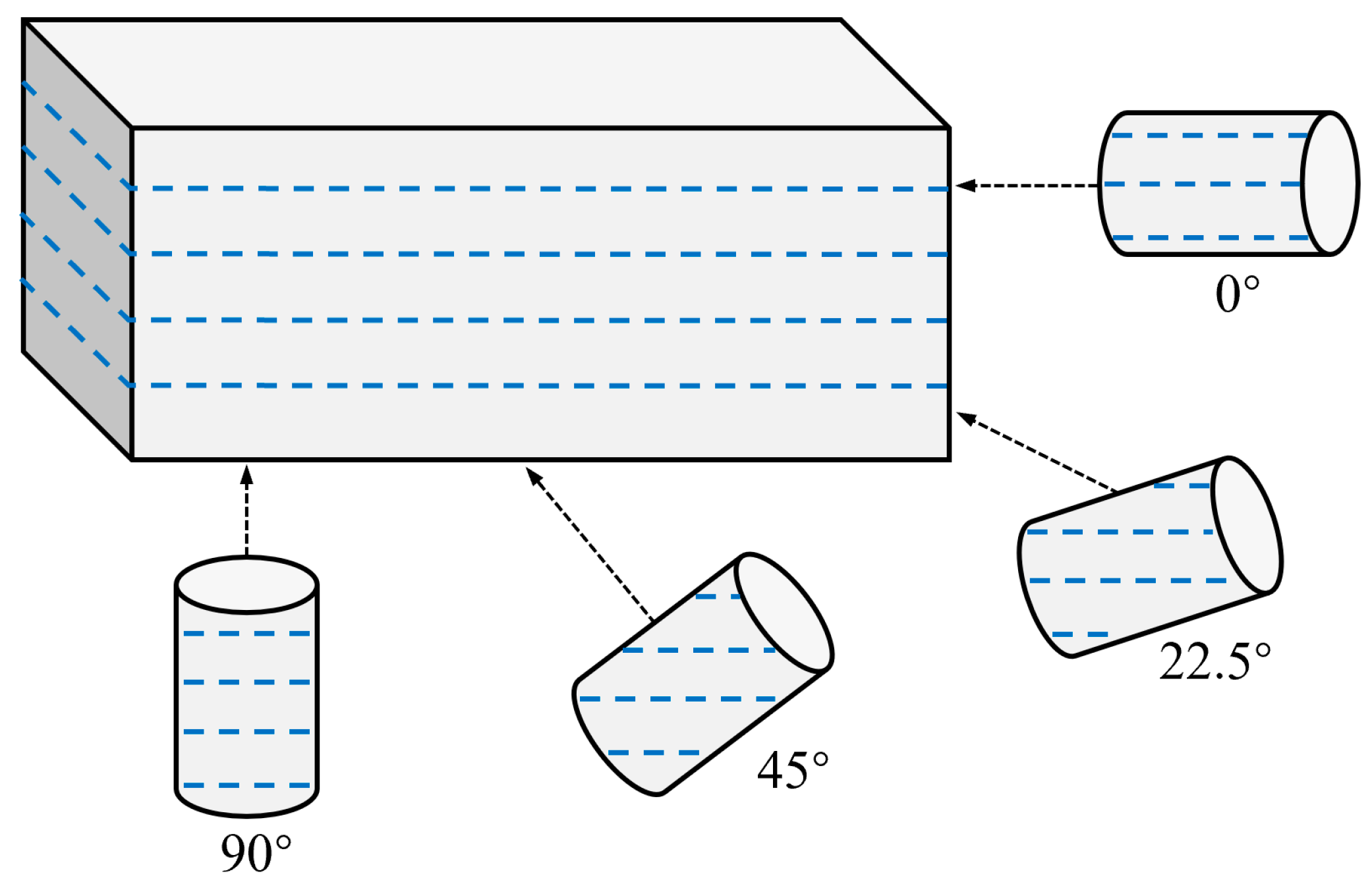
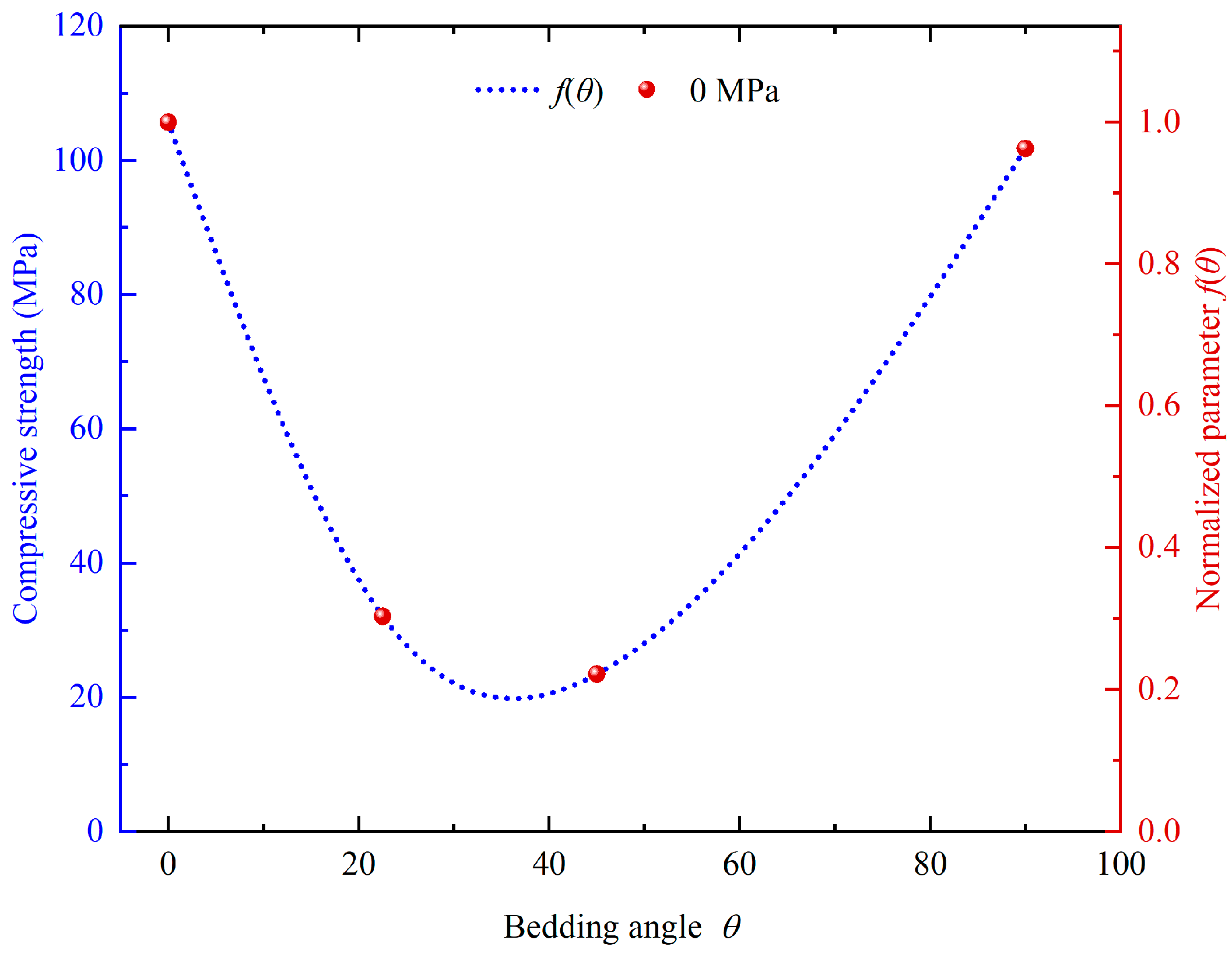
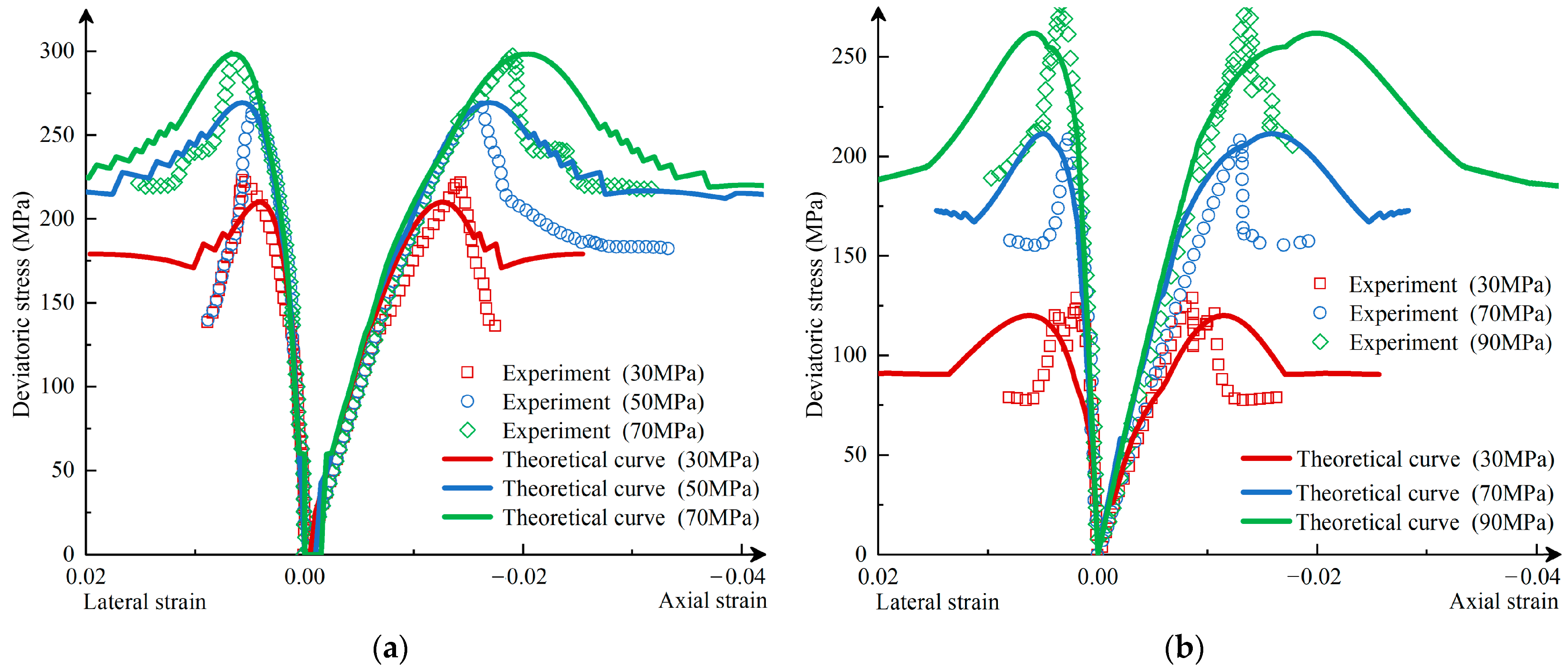
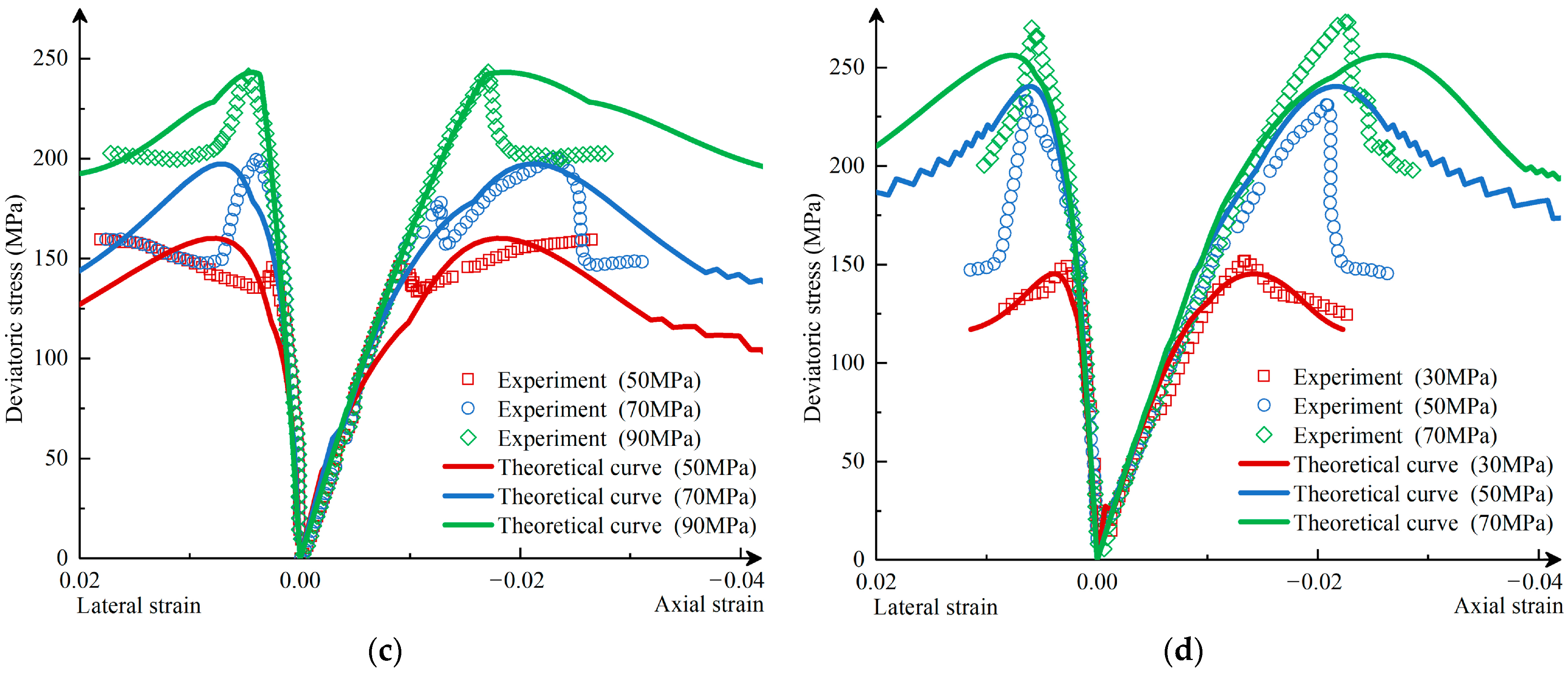
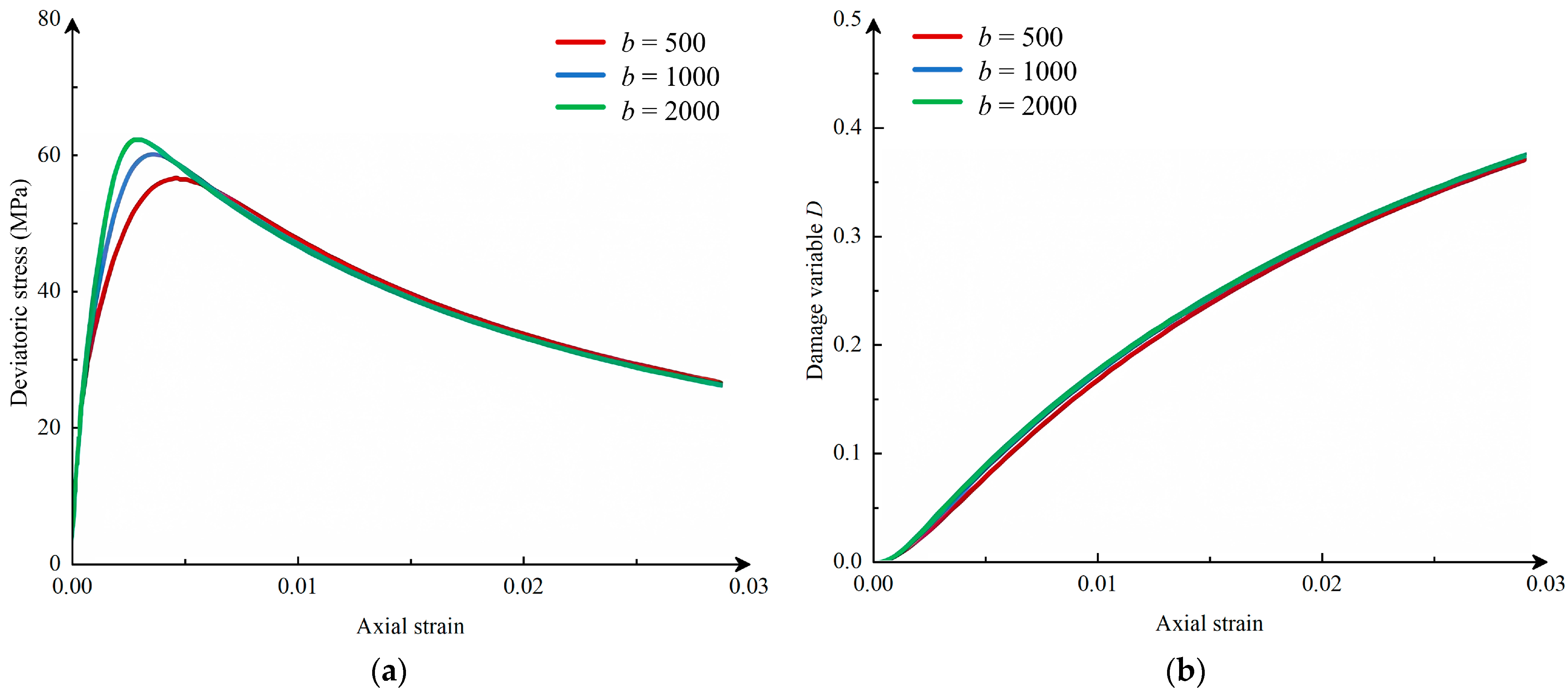
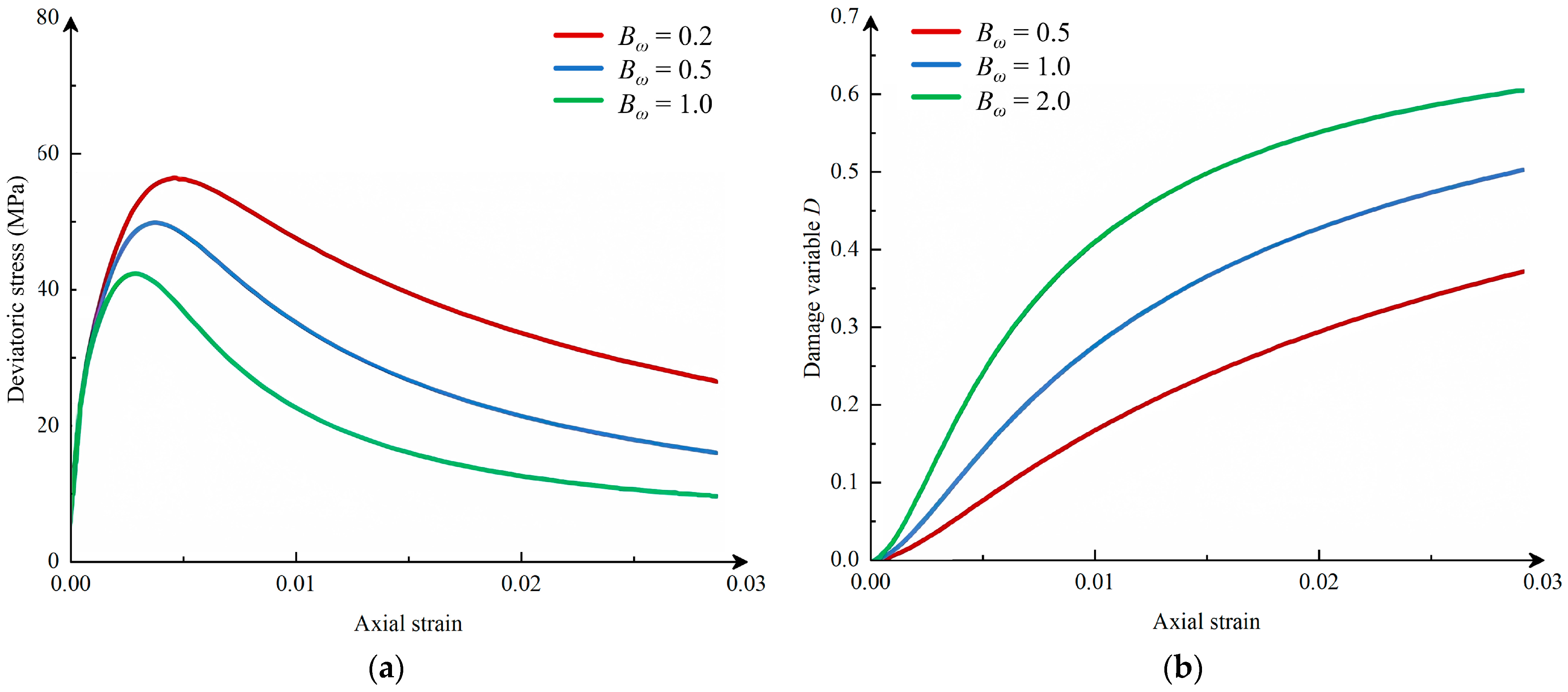


| Name | Value |
|---|---|
| Elastic parameters | E = 8.7 GPa, ν = 0.3 |
| Plastic parameters | α1 = 1.27, α2 = 0.45, = 45.5 MPa, h1 = 1.0, h0 = 2.2, b = 2000 |
| Damage parameters | ωc = 0.7, Bω = 0.35 MPa−1, r = 0.2 |
| Damage softening parameters | a = 3.45exp(−0.047σ3) + 1 |
| Name | Value |
|---|---|
| Elastic parameters | E = 28.0 GPa, ν = 0.14 |
| Plastic parameters | α1 = 0.8, α2 = 0.3, = 87.5 MPa, h1 = 1.0, h0 = 3.6, b = 500 |
| Damage parameters | ωc = 0.7, Bω = 0.5 MPa−1, r = 0.2 |
| Damage softening parameters | a = 3.45exp(−0.047σ3) + 1 |
Disclaimer/Publisher’s Note: The statements, opinions and data contained in all publications are solely those of the individual author(s) and contributor(s) and not of MDPI and/or the editor(s). MDPI and/or the editor(s) disclaim responsibility for any injury to people or property resulting from any ideas, methods, instructions or products referred to in the content. |
© 2024 by the authors. Licensee MDPI, Basel, Switzerland. This article is an open access article distributed under the terms and conditions of the Creative Commons Attribution (CC BY) license (https://creativecommons.org/licenses/by/4.0/).
Share and Cite
Jin, X.; Ding, Y.; Qiao, K.; Wang, J.; Fang, C.; Hu, R. Coupled Elastic–Plastic Damage Modeling of Rock Based on Irreversible Thermodynamics. Appl. Sci. 2024, 14, 10923. https://doi.org/10.3390/app142310923
Jin X, Ding Y, Qiao K, Wang J, Fang C, Hu R. Coupled Elastic–Plastic Damage Modeling of Rock Based on Irreversible Thermodynamics. Applied Sciences. 2024; 14(23):10923. https://doi.org/10.3390/app142310923
Chicago/Turabian StyleJin, Xin, Yufei Ding, Keke Qiao, Jiamin Wang, Cheng Fang, and Ruihan Hu. 2024. "Coupled Elastic–Plastic Damage Modeling of Rock Based on Irreversible Thermodynamics" Applied Sciences 14, no. 23: 10923. https://doi.org/10.3390/app142310923
APA StyleJin, X., Ding, Y., Qiao, K., Wang, J., Fang, C., & Hu, R. (2024). Coupled Elastic–Plastic Damage Modeling of Rock Based on Irreversible Thermodynamics. Applied Sciences, 14(23), 10923. https://doi.org/10.3390/app142310923






